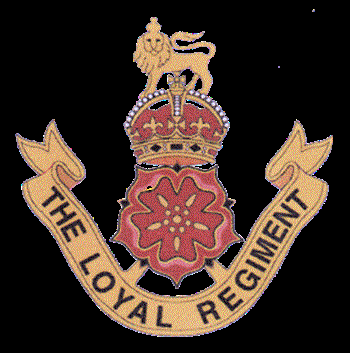
Harold John Thomas Swain

Artificer 6899
Later
Loyal North Lancashire Regiment, 10th Battalion
Private 33916
 |  | |
|
Army Cyclist Corps Artificer 6899 Later Loyal North Lancashire Regiment, 10th Battalion Private 33916 | ||
| Died 11th April 1917 |
Harold Swain's Parents | ||
Harold Swain was born in 1893 to parents Hugh and Emma Swain. Hugh SwainHarold’s father, Hugh, was the son of a grocer and in 1871 the family lived at Causeway, on the Calne Road out of Chippenham. One presumes they had a grocer’s shop there. Ten years later, the 1881 census shows that that family lived in the High Street at Kington St Michael, north of Chippenham. Hugh was 15 years old in 1881 and already listed as an apprentice in the printing trade. He remained in this trade all his working life.Emma ColemanEmma Coleman, Harold’s mother, was from the Lowden area of Chippenham and her father was a farm labourer. Their residence in 1881 was called Rosalind Villa. At this time, one of Emma’s brothers was an agricultural labourer, like his father. Another, Charles, was listed as a ‘milk factory operative’. It is very likely that he worked in the factory that is now known as Avon Bridge House, right by the town bridge in the centre of Chippenham; this was the first condensed milk factory in the world and later belonged to Nestlé. | ||
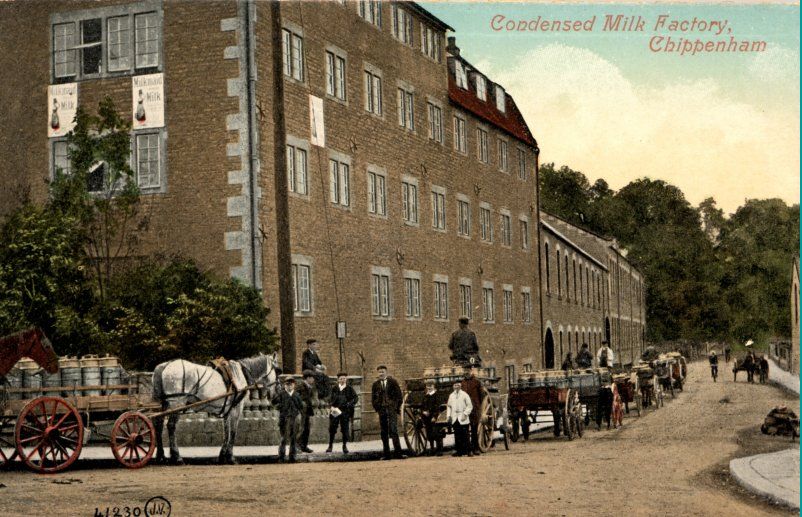 | ||
|
The milk factory in Chippenham where Harold Swain’s uncle worked |
The Swain Family |
|
Hugh and Emma married in Chippenham in 1888. The couple moved to Bath soon after their marriage; we know that the first of their four children, Elsie, was born in Walcot in 1889 and the 1891 census lists the family with the first two children (the second child was Percy, born 1891), giving their address as 1 Newark Street. Newark Street once ran northwards from Dorchester Street and continued as Philip Street up to Old Orchard Street. The names of Newark Street and Philip Street have been recreated in the new Southgate development, but are not in exactly the same place. |
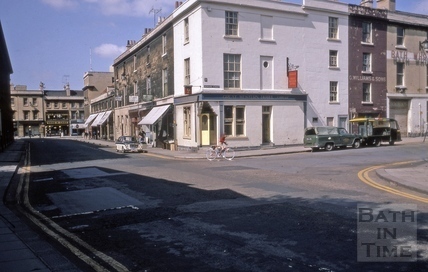 | ||
|
Newark Street in Bath (the road to the right), where the Swain family lived at the time of
Harold’s birth and which has since been built over by successive Southgate
developments. The narrow white house behind the green pick-up was number 1. [Image: Bath In Time] |
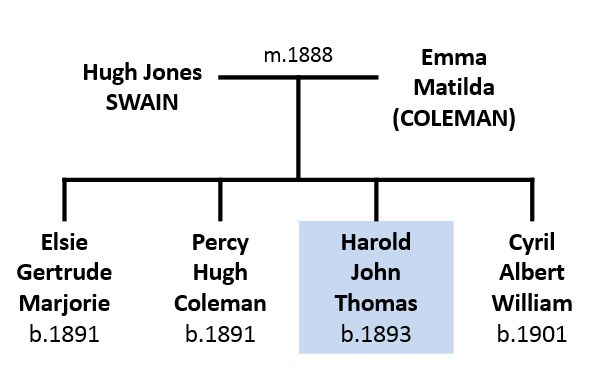 |
|
Harold was born in 1893 in Chippenham (his mother Emma probably returned to her maternal family to give birth), shortly after which the family moved to 5 Maybrick Road, just above Moorland Road, where the family lived until 1907. The final child, Cyril, was born in 1901. |
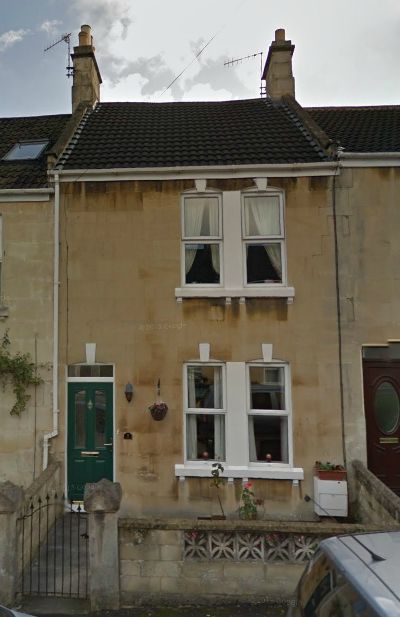 | ||
|
5 Maybrick Road, where the Swain family lived 1893-1907 and from where Harold would have walked to school throughout his time at South Twerton |
|
In around 1907 or 1908 the family moved to nearby West Avenue and lived for several years at number 101. The 1911 census shows the family here with Harold, aged 17, listed as a ‘repairer’, working for a bicycle dealer, which we know to have been Halfords, whose shop was in Stall Street. |
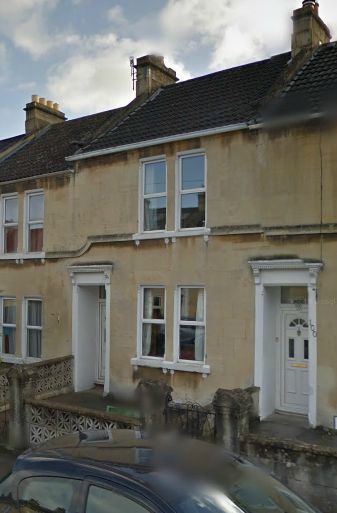 | ||
|
101 West Avenue, home to the Swain family 1907-1914 |
In 1912, Harold’s father Hugh was elected Vicar’s Warden at Ascension Church. This indicates that the family was very much involved with the life of the church, which was next door to South Twerton School. Harold himself was clearly something of a sportsman, featuring in the Bath Thursday team that won the Thursday league in 1913, as evidenced by this newspaper item from the Bath Chronicle & Weekly Gazette of 8th March of that year: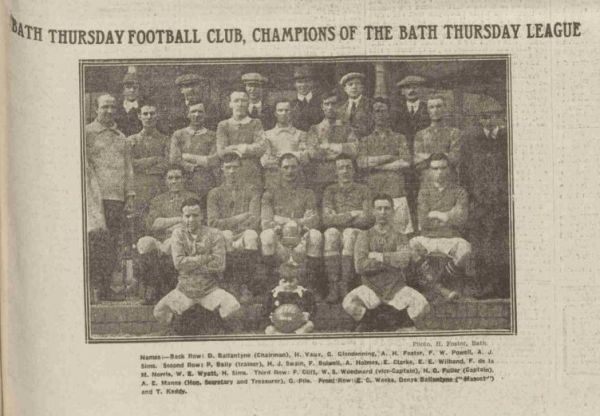 Harold Swain, second from the left in the top row of players (next to the trainer) In 1914, the Swains moved around the corner to 16 South Avenue. |
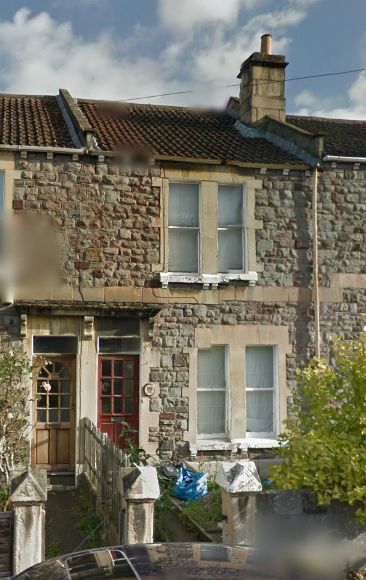 | ||
|
16 South Avenue, home to the Swain family during WW1 and beyond |
|
The postcard below shows South Avenue as it would have looked in Harold Swain's time. There were many more shops dotted around Oldfield Park at the time, such as the one seen here on the left. This postcard was shared by Nick vincent on the popular Facebook group 'Bath Somerset - Old photographs & postcards' and he kindly gave permission for it to be reproduced here. The small sign on the house to the right of the photo says "To the adult school"; there were evening classes held at South Twerton for adults and the lane up the back of the east side of West Avenue would have led there. We are not aware of any other adult school in the area. |
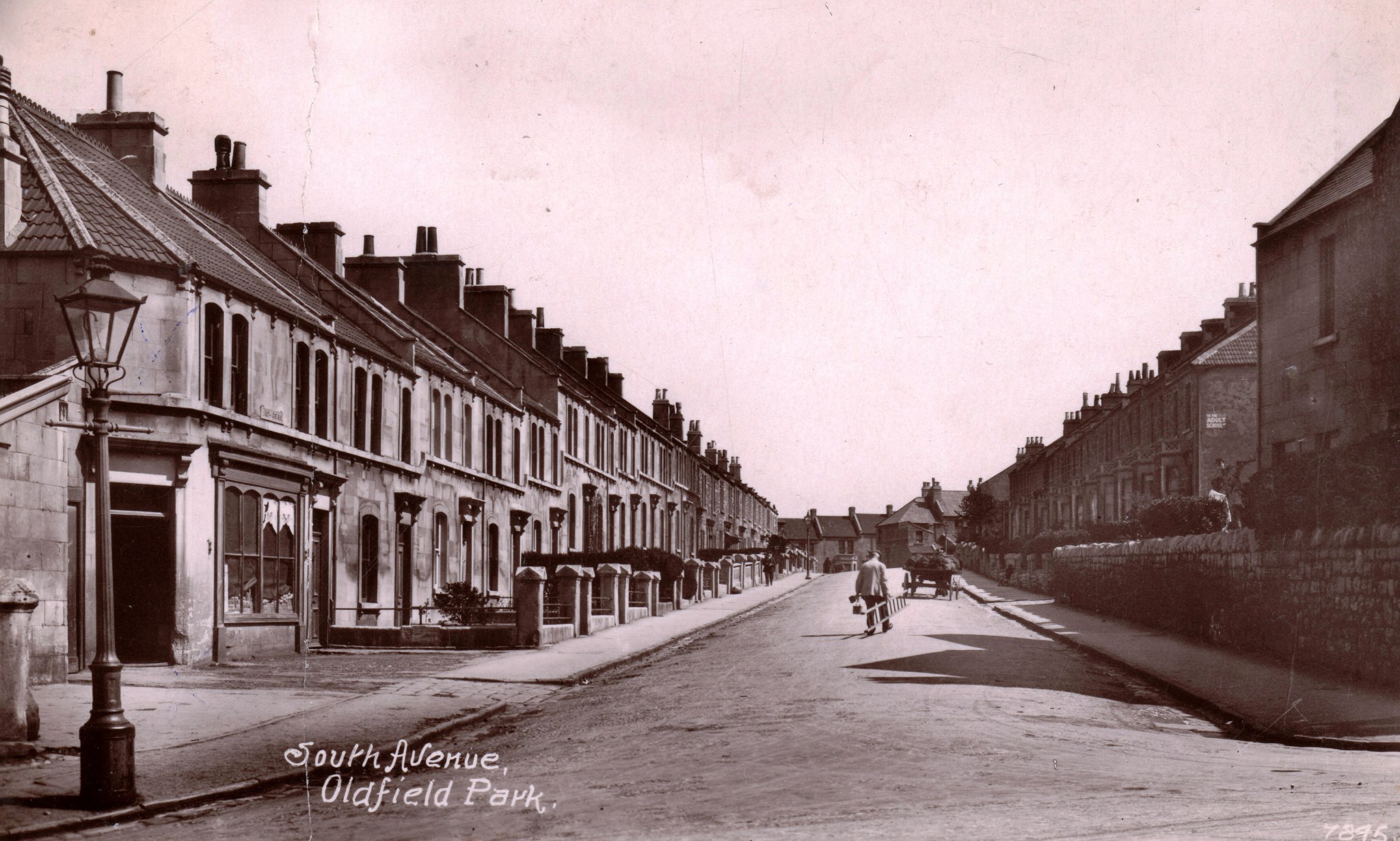 | ||
| South Avenue, circa 1910 |
Harold Swain in WW1 | ||
Army Cyclist Corps
Harold’s work in
the bicycle business in Bath would have stood him in good stead for his first military
role. After enlistment, Harold was an Artificer in the Army Cyclist Corps. | ||
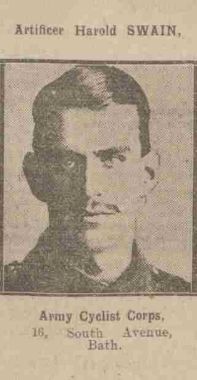 | ||
|
Harold Swain’s picture appeared in the Bath Weekly Chronicle &
Gazette in October 1915 among a number of other photographs of Bathonians
serving in the War. Such entries were always called ‘for King & Country’. |
Following the success of bicycles for certain types of work in the campaigns in South Africa (Boer Wars), cyclist corps were built up such that, in August 1914 there were 14 cyclist battalions in the Territorial Force, ten of these formed of regular infantry battalions (i.e. these were trained infantrymen). These territorial units all served in coastal defence work within the UK for the first months of the war, but in 1915 the Army Cyclist Corps itself, in which Harold first served, was formed. Their roles were in courier and messenger work, reconnaissance and also supporting military police work. |
|
The badge of the Army Cyclist Corps |
|
The 'Bath In Time' archive contains many hundreds of images from a prolific local photographer, George Dafnis, who served with the Post Office and was stationed as postmaster at military training camps on Salisbury Plain and in Dorset during WW1. His photographs clearly show members of the Army Cyclist Corps at training camps at that time: |
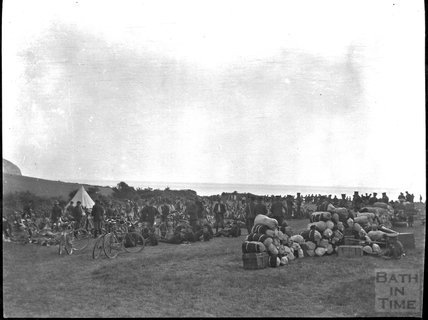 | ||
|
A training camp on Ballard Down, Dorset, during WW1. To the left are
numerous bicycles, denoting the presence of a cyclist battalion or an Army Cyclist Corps unit. [Image: Bath In Time] |
| We have been fortunate to be able to make contact with a member of Harold's family, namely the son-in-law of the partner of Harold's nephew, who lives in Chippenham. He has supplied us with this wonderful photgraph of Harold in uniform. The crossed hammer and pincers on his sleeve denote his rank of Artificer. The other sleeve insignia, apparently that of a fusilier regiment, may show that he was attached to a fusilier regiment at the time the photograph was taken. |
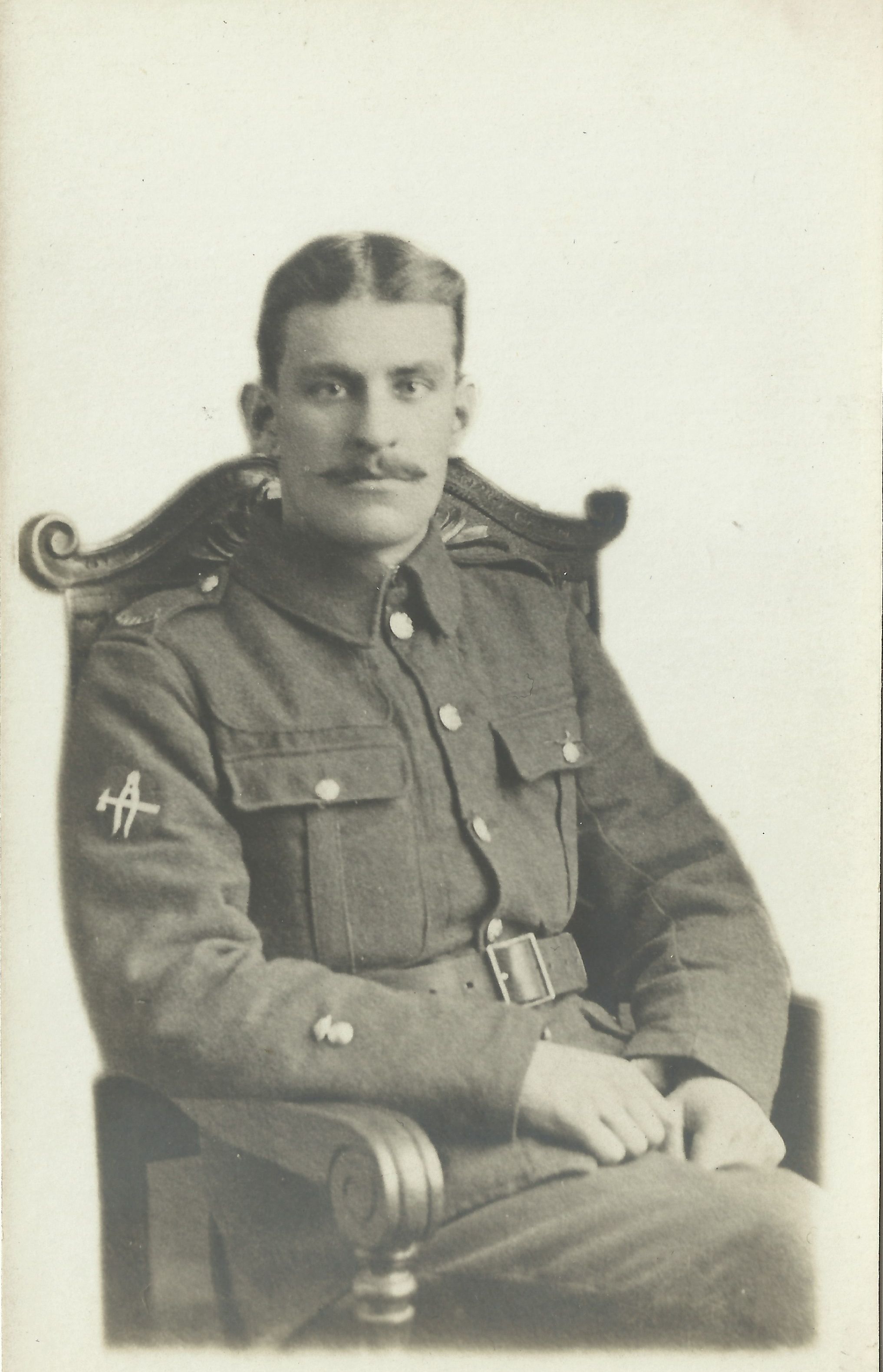 Photograph courtesy of Chris Dallimore |
| From the same source, we also have an intriguing image of a certificate documenting an entry for Harold Swain on the South Twerton Roll of Honour. After WW1, a 'Roll of Honour' was usually a list of those who had given their lives during the war; during the war, however, the term was already in use for a list of those who had joined up to serve King & Country. This document would lead us to believe that there is (or was), somewhere, a physical Roll dating from the period of the War. It must also be assumed that similar certificates would have been issued for all others who heeded the country's call and that these may also come to light. |
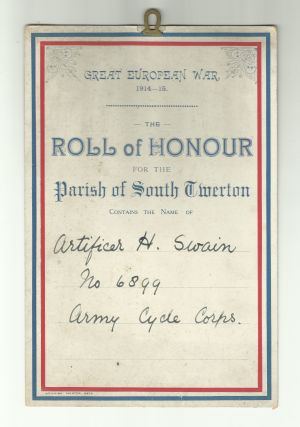 |
|
Bicycles became somewhat less useful as trench warfare increasingly dominated the battlefield on the Western Front, due both to the terrain and to the ‘immobility’ of the situation. Often, Cyclist Corps personnel then reverted to more general infantry roles, with the transition to more traditional infantry units often being formalised with an enlistment in that unit. In this context, Harold came to join the 10th Battalion of the Loyal North Lancashire Regiment. The story of another member of the Army Cyclist Corps who served with the 10th Bn, Loyal North Lancs, is that of Private Frederick J. Barker, posted on a memorial website at loyalregiment.co.uk. Private Barker’s serial number (33813) is very close to that of Harold (33916), which corresponds to the idea that Harold joined at the same time or soon after. We might therefore assume that Harold’s transition into the Loyal North Lancs, a regiment otherwise mainly made up of men who had joined up in Lancashire, was the same. From loyalregiment.co.uk: “…[Frederick] transferred to the South Midland Division Cyclist Company
with which he trained at Weston-super-Mare, Salisbury Plain, Cheltenham and
Chiseldon. At the end of his training, he was assigned to the North Lancashire
Regiment and went overseas in early December 1916. The 10th Battalion, Loyal North Lancashire Regiment, formed part of 112th Brigade in 37th Division. |
Harold Swain's Death | ||
|
Harold was killed on 11th April 1917. This is a notorious date in the history of the 10th Bn, Loyal North Lancs, as they were engaged in action around the small hilltop village of Monchy-le-Preux on this, the opening day of the Battle of Arras. This Battle went on to claim 159,000 British casualties in just 39 days. Extract from the War Diary of the 10th Bn., Loyal North
Lancs. ARRAS 11/4/1917 During the night orders were received that L N Lancs were to continue the advance and attack at 5am going through East Lancs and attacking the trenches, having as our objective the 'GREEN LINE' and in particular the wood in 0.8 Central. 5am: The Battalion, having previously got into position for such advance, almost immediately came into full view of the enemy and was met with very heavy machine gun and shell fire. 5.30am: We received orders not to advance until barrage opened. By this time, we had carried by assault, the enemy trench in front (East of Sunken Road) and were establishing ourselves in shell holes 100 yards further East. It was at this time that Capt. Pesket, 2nd Lt Ibbotson and 2nd Lt Goodman were killed. During the assault we suffered very heavy casualties and were being enfiladed from Monchy le Preux. The right flank perceiving that they were in the air and appreciating the fact that it remained as such, there was a likelihood of their being outflanked, boldly determined to risk all and assault a small trench running southwards from CAMBRAI ROAD in the direction of GUEMAPPE and about 30 yards East of Sunken Road before mentioned. A tank apparently also appreciating the situation in a like manner, came to their aid. On obtaining possession of the trench, Corpl Leonard and L/Cpl R Dunwoodie and six men were all that was left. These eight men boldly bombed along the trench Southward killing more than a dozen Boche, taking 3 prisoners and found themselves in complete possession. To their utmost surprise, 7 Boche officers miraculously appeared, apparently from nowhere, whereupon the officers suffered the same fate as their men. Two machine guns were captured in this gallant assault but as the new garrison were so weak in numbers and fearing that they might eventually be in their turn evicted, they blew them up. These men retained possession of the trench as did Capt Garrett, ably assisted by 2nd Lt Deacon (being the only two officers now left) and CSM Webster with 60 men, made themselves masters of the situation of the corresponding trench running Northwards from the CAMBRAI Road. Here the garrison remained throughout the day, although there were signs of the enemy massing for a counter attack from the South. It was about this time that 2/Lt Parker died after being badly wounded. During this period 2/Lt Deacon received two wounds, but would not desert his Captain or his men. About 3 hours after entering the trench, some of the 3rd Dragoon Guards, acting as Infantry, came up on their left. This gave them some breathing space. During this time men of the East Lancs and 10th L N Lancs oozed from shell holes and thickened the line. The Commanding Officer and Adjutant, having collected en route stragglers of all Battalions to the number of about 50, arrived on the scene. By this time and with the assistance of these reinforcements, Capt Garrett was the complete master of the situation. From this time onwards, reinforcements of officers and men from other Battalions kept arriving. 1.50pm: The Commanding Officer sent in a report to the General informing him that the situation had improved considerably and he had made plans for bombing parties to proceed along both sides of the CAMBRAI ROAD and to attack the enemy trench after nightfall, which was about 300 yards in front of our line as it was not deemed advisable at that moment to advance further, knowing full well that we were well in advance of all troops on our Right and Left, besides which, in our present position we had command of a good field of fire to our front line and could also enfilade the enemy on our right where the troops on that flank would advance further. 5.00pm: We received orders that we would be relieved at 6.30 pm & immediately informed Capt Garrett to hold himself in readiness to be relieved. This relief was not complete until 1 am. The men, being in a very exhausted condition withdrew to Tilloy, where we spent the remainder of the night. TILLOY WOOD 12/4/17 8.00am: Roll Call. Only a few of the brave fellows left. Our
losses were estimated at 13 Officers and 286 men. That is 60% of our fighting strength. | ||
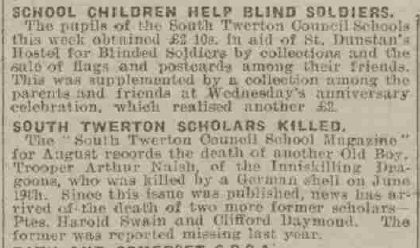 | ||
|
The above notices appeared in the Bath Chronicle & Weekly Gazette
in July 1918, more than a year after Harold Swain died. The lower item reports the deaths of Arthur Naish, Harold Swain
and Clifford Daymond, while the upper shows South Twerton school families doing
their bit to support wounded soldiers. |
Decoration |
|
Harold Swain would have received the British War Medal 1914-18 and the Allied Victory Medal posthumously. |
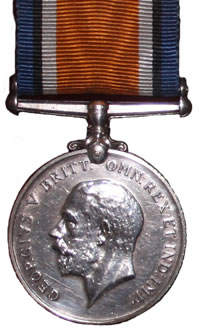 | 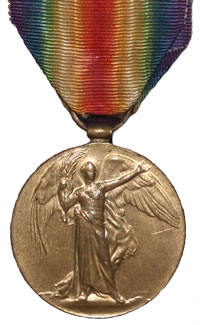 | ||
| British War Medal 1914-18 | Allied Victory Medal |
Commemoration | ||
 In addition to his commemoration on the South Twerton School memorial, Harold Swain is commemorated as follows: | ||
|
Arras Harold is commemorated on the Arras Memorial, which commemorates 34,785 allied soldiers who died with no known grave in the Arras sector between Spring 1916 and August 1918. |
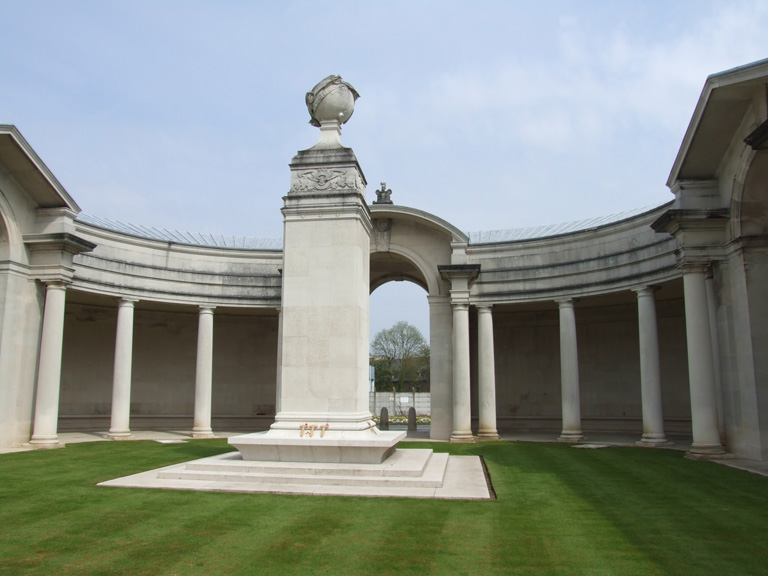 | ||
|
The Arras Memorial |
|
Bath War Memorial See separate page for details of the Bath War Memorial. Harold Swain's inscription: |
| AWAITING IMAGE |
|
Ascension Church Memorial As a parishioner of the Ascension Church and with his father holding the office of Vicar's Warden, Harold Swain's name is inscribed on the oak tablet in the Church (see separate page for details of the Ascension Church Memorial). The reference to the Royal Engineers probably means that Harold was attached to the Engineers while with the Cyclist Corps and does not reflect his status at time of death, which was 'Private' in the Loyal North Lancs Regt. |
 |
|
Family Commemoriation Harold Swain's family kept his memory alive in the years after the war through a series of 'In memoriam' announcements in the Chronicle. |
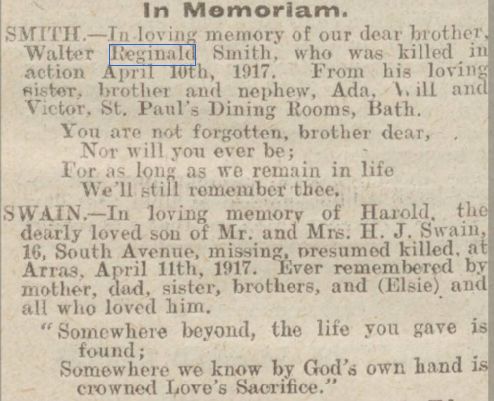 | ||
| The lower of the above notices was posted in 1924 by Harold Swain's
parents. The notice below is from 1925. Although Harold had a sister called Elsie, it is likely that the 'Elsie' who receives special mention was a sweetheart, as she is listed in addition to the 'sisters'. | ||
 |
Further Information |
Living relativesIt would be great to hear from any living relatives of Harold Swain. We know of descendants of Harold Swain's siblings as follows:
Please get in touch!If you have any further information on Harold Swain, or want to suggest corrections / improvements for this page, please use the Contact page to get in touch.All additions and further information will be credited appropriately. |